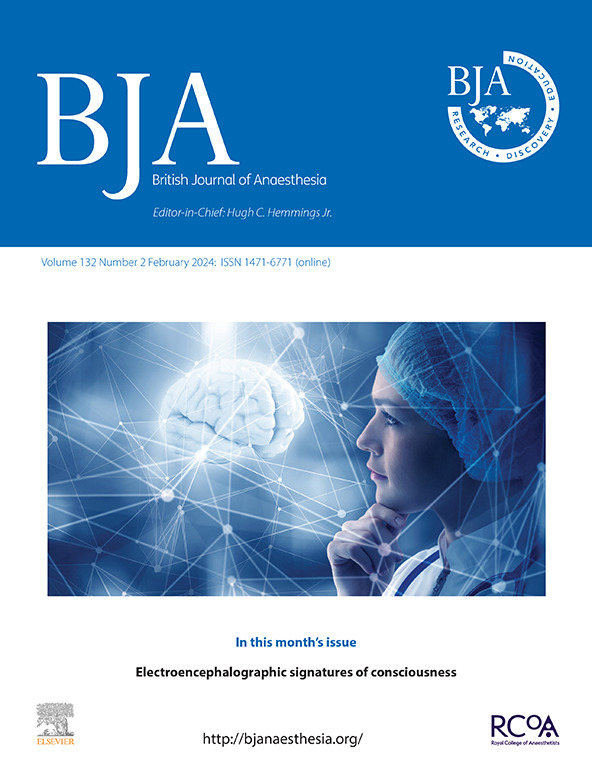目标导向血流动力学治疗围手术期质量倡议共识声明。
IF 9.2
1区 医学
Q1 ANESTHESIOLOGY
引用次数: 0
摘要
围手术期目标导向血流动力学治疗(GDHT)包括各种协议化的方法来评估和管理手术患者的循环系统和血流。在此,我们提出了2023年6月在英国伦敦举行的第11届围手术期质量倡议(POQI)共识会议上关于围手术期GDHT的最新共识声明。提出了与GDHT的定义、成分和潜在生理学相关的陈述。我们建议在特定情况下考虑使用GDHT,包括在体外循环(CPB)期间、心脏手术后和髋部骨折手术期间。然而,在这些情况下,证据水平很弱。对于接受重大非心脏手术的中高风险患者,临床医生可考虑在个体患者基础上使用GDHT方案;然而,我们不建议使用固定的低剂量肌力输注作为GDHT方案的一部分。我们不建议接受重大腹部手术的患者常规使用GDHT方案。目前没有足够的证据推荐在急诊腹部手术中常规使用谷氨酰胺。未来的研究应该集中在GDHT的个体化,以满足个体患者的血流动力学需求,新的范例,如技术辅助GDHT方案的交付,以及使用人工智能的预测模型的作用。本文章由计算机程序翻译,如有差异,请以英文原文为准。
Perioperative Quality Initiative consensus statement on goal-directed haemodynamic therapy.
Perioperative goal-directed haemodynamic therapy (GDHT) includes a variety of protocolised approaches to the assessment and management of the circulatory system and blood flow for patients undergoing surgery. Here we present updated consensus statements on perioperative GDHT developed during the 11th Perioperative Quality Initiative (POQI) consensus conference meeting held in London, UK in June, 2023. Statements relating to the definitions, components, and underlying physiology surrounding GDHT are proposed. We recommend considering use of GDHT in specific settings including during cardiopulmonary bypass (CPB), after cardiac surgery, and during hip fracture surgery. However, the level of evidence is weak in these settings. Clinicians can consider use of GDHT protocols on an individual patient basis for moderate- to high-risk patients undergoing major noncardiac surgery; however, we recommend against use of fixed low-dose inotrope infusions as part of GDHT protocols. We do not recommend routine use of GDHT protocols for patients undergoing major elective abdominal surgery. There is currently insufficient evidence to recommend routine use of GDHT during emergency abdominal surgery. Future research should focus on individualisation of GDHT to individual patients' haemodynamic requirements, newer paradigms such as technology-assisted delivery of GDHT protocols, and the role of predictive models using artificial intelligence.
求助全文
通过发布文献求助,成功后即可免费获取论文全文。
去求助
来源期刊
CiteScore
13.50
自引率
7.10%
发文量
488
审稿时长
27 days
期刊介绍:
The British Journal of Anaesthesia (BJA) is a prestigious publication that covers a wide range of topics in anaesthesia, critical care medicine, pain medicine, and perioperative medicine. It aims to disseminate high-impact original research, spanning fundamental, translational, and clinical sciences, as well as clinical practice, technology, education, and training. Additionally, the journal features review articles, notable case reports, correspondence, and special articles that appeal to a broader audience.
The BJA is proudly associated with The Royal College of Anaesthetists, The College of Anaesthesiologists of Ireland, and The Hong Kong College of Anaesthesiologists. This partnership provides members of these esteemed institutions with access to not only the BJA but also its sister publication, BJA Education. It is essential to note that both journals maintain their editorial independence.
Overall, the BJA offers a diverse and comprehensive platform for anaesthetists, critical care physicians, pain specialists, and perioperative medicine practitioners to contribute and stay updated with the latest advancements in their respective fields.

 求助内容:
求助内容: 应助结果提醒方式:
应助结果提醒方式:


